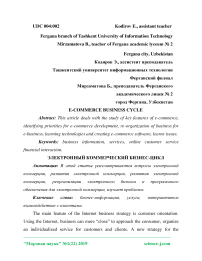E-commerce business cycle
Автор: Kodirov E.
Журнал: Мировая наука @science-j
Рубрика: Основной раздел
Статья в выпуске: 1 (22), 2019 года.
Бесплатный доступ
This article deals with the study of key features of e-commerce, identifying priorities for e-commerce development, re-organization of business for e-business, learning technologies and creating e-commerce software, learns issues.
Business information, services, online customer service financial interaction
Короткий адрес: https://sciup.org/140263818
IDR: 140263818
Текст научной статьи E-commerce business cycle
The main feature of the Internet business strategy is customer orientation. Using the Internet, business can more “close” to approach the consumer, organize an individualized service for customers and clients. A new strategy for the development of the company is that the Internet project is starting to develop towards corporate offline business. There are two possible strategies:
-
- An Internet project creates its own offline business following the model of traditional business schemes of companies of a similar profile. But “from scratch” it is very difficult to create your own offline business, because, for example, the growth in sales for a popular Internet project often turns out to be greater than the rate of increase in the capacity of servicing resources for the corresponding offline activity;
-
- The purchase of some kind of offline company for an Internet project, corresponding to the profile of the Internet project. But it should be noted that creating your own Internet project is advisable at the second stage of development, i.e. only when the Internet project is already promoted and makes a profit. [1]
E-commerce facilitates business reengineering - a process that is currently widespread among the largest companies in the economically developed countries of the West. The goals of e-commerce are similar to the goals that are solved in the process of reengineering, such as:
-
- reduction of costs;
-
- reducing the time of the production cycle;
-
- acceleration of customer requests;
-
- improving the quality of service.
-
- business information / business environment systems;
-
- video conferencing;
-
- training;
-
- financial interaction;
-
- new relations between companies based on electronic technologies;
-
- cooperation, etc.
The most important thing about how e-commerce is changing a business is how new customer relationships are built, including:- online advertising and marketing;
-
- the possibility of placing an order online;
-
- online customer service;
-
- maximum compliance of products and services to customer requests.
E-commerce also reduces costs associated with the acquisition of goods and inventory management, through direct effective interaction with a wide range of suppliers and trading partners. Different types of businesses re-create distribution services based on Business-to-Business applications that add value. [2]
The Internet business is information. A number of companies are engaged in the supply of products, the basis of which is also information. These are interactive games, audio and video materials. Models based on the use of web technologies can include all phases of the transaction, such as:
-
- request of information by the client from the supplier;
-
- A system to confirm the presence of goods from the supplier;
-
- client system that allows you to make a purchase of a product;
-
- supplier's system that accepts / approves the purchase;
-
- supplier's system, confirming the purchase;
There are many technologies used to implement e-commerce solutions, for example, Electronic Data Interchange (EDI) - the interchange of electronic data
EDI technology is a very fast way to exchange business documents using computer connections between different companies. [4]
Simply put, EDI is a standard that converts the format of a transmitted document into the format of a receiving computer. Benefits of using EDI:
-
- all kinds of costs associated with the preparation of documentation on paper are reduced;
-
- the solution of problem situations is improved;
-
- customer service is improving;
-
- expanding customer base / suppliers.
Initially, EDI technology was used to improve the conduct of individual processes, such as automating payment calculations or the process of transferring funds from accounts. Currently, EDI is used in e-commerce when connecting external and internal business processes that allow companies to improve their performance on a scale like never before. Using the Internet as an EDI communication channel, we can significantly reduce costs and expand the range of trading partners. Many companies around the world use the Internet in their businesses. [3]
E-commerce has begun to transform the activities of enterprises into a network of virtual communities of organizations, each of which can concentrate its activities on those areas in which it is most competent to deliver a complete production solution to its customers.
Список литературы E-commerce business cycle
- Brunner M. Principles of e-business. M.: World of e-commerce, 2000.
- Evsyukov D.E. Electronic money as a new component of the monetary system // ECO. 2001. No. 5.
- Vinogradov M.V. Electronic payments: Let's open the "black box" // Banking technologies. 2004. № 4.
- Zemskov A.I. Access to electronic resources from Bonn to Vladivostok // Scientific and technical libraries. 2000. № 7.


